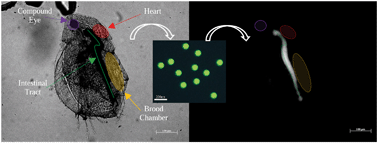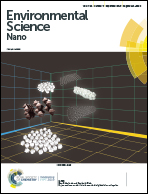Evaluation of non-invasive toxicological analysis of nano-polystyrene in relative in vivo conditions to D. magna
Abstract
Nano-plastic (NP) usage is increasing across many industries; however, the risks posed from waste production or their accidental release into the environment have not been well investigated. Additionally, the resulting effects on the organisms within various environments based on NP exposure have not been thoroughly investigated. To contribute to this information, our current study focused on using an OECD test with additional validation tests to replicate the effects of a specific NP entering the freshwater environment. The current research analysed the potential toxicological, developmental and reproductive effects caused by fluorescent nano-polystyrene spheres (NPS) in juvenile (neonate) freshwater planktonic crustaceans, Daphnia magna. D. magna neonates were exposed for 24 h to a concentration range of 0–100 μg mL−1 of 100 nm diameter NPS as a mortality/immobility (MI) test. MI testing showed that the D. magna exhibited significant NPS consumption at all concentrations; however, adverse effects only occurred after exposure to 30 μg mL−1. The resulting EC50 for the NPS MI testing was 86.3 1 μg mL−1. Florescence imaging showed that the NPS were isolated to the D. magna intestines, even with exposure to a low concentration, producing a distinct emission, with no distinguishable NPS present in the other organs. UV-vis fluorimetry displayed an indirect relation between the initial consumption of NPS and increase in NPS exposure. The fluorimetry results showed an increase in NPS uptake up to 30 μg mL−1, and then a decrease since D. magna slowed consumption, and further increase after 100 μg mL−1. This indicated a change in the ratio of NPS within the intestines of Daphnia, which is independent to the exposure concentration. Raman spectroscopy analysis of the control D. magna produced a consistent emission spectrum, but with large FWHM peaks from its organic structures. The NPS-exposed D. magna clearly produced a clear and sharp peak attributed to a pure polystyrene signal following careful Z-mapping, which was not detected in the control samples. The results clearly present the successful Raman detection of the styrene signal from the NPS-exposed D. magna without significant pre-processing of the neonates.



 Please wait while we load your content...
Please wait while we load your content...